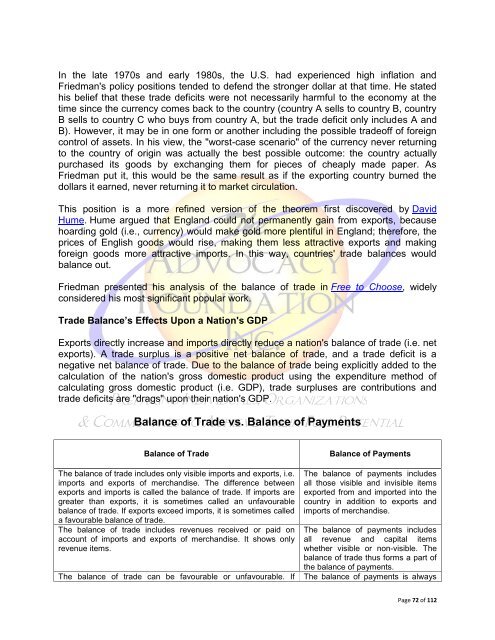De-Industrialization
De-Industrialization
De-Industrialization
Create successful ePaper yourself
Turn your PDF publications into a flip-book with our unique Google optimized e-Paper software.
In the late 1970s and early 1980s, the U.S. had experienced high inflation and<br />
Friedman's policy positions tended to defend the stronger dollar at that time. He stated<br />
his belief that these trade deficits were not necessarily harmful to the economy at the<br />
time since the currency comes back to the country (country A sells to country B, country<br />
B sells to country C who buys from country A, but the trade deficit only includes A and<br />
B). However, it may be in one form or another including the possible tradeoff of foreign<br />
control of assets. In his view, the "worst-case scenario" of the currency never returning<br />
to the country of origin was actually the best possible outcome: the country actually<br />
purchased its goods by exchanging them for pieces of cheaply made paper. As<br />
Friedman put it, this would be the same result as if the exporting country burned the<br />
dollars it earned, never returning it to market circulation.<br />
This position is a more refined version of the theorem first discovered by David<br />
Hume. Hume argued that England could not permanently gain from exports, because<br />
hoarding gold (i.e., currency) would make gold more plentiful in England; therefore, the<br />
prices of English goods would rise, making them less attractive exports and making<br />
foreign goods more attractive imports. In this way, countries' trade balances would<br />
balance out.<br />
Friedman presented his analysis of the balance of trade in Free to Choose, widely<br />
considered his most significant popular work.<br />
Trade Balance’s Effects Upon a Nation's GDP<br />
Exports directly increase and imports directly reduce a nation's balance of trade (i.e. net<br />
exports). A trade surplus is a positive net balance of trade, and a trade deficit is a<br />
negative net balance of trade. Due to the balance of trade being explicitly added to the<br />
calculation of the nation's gross domestic product using the expenditure method of<br />
calculating gross domestic product (i.e. GDP), trade surpluses are contributions and<br />
trade deficits are "drags" upon their nation's GDP.<br />
Balance of Trade vs. Balance of Payments<br />
Balance of Trade<br />
The balance of trade includes only visible imports and exports, i.e.<br />
imports and exports of merchandise. The difference between<br />
exports and imports is called the balance of trade. If imports are<br />
greater than exports, it is sometimes called an unfavourable<br />
balance of trade. If exports exceed imports, it is sometimes called<br />
a favourable balance of trade.<br />
The balance of trade includes revenues received or paid on<br />
account of imports and exports of merchandise. It shows only<br />
revenue items.<br />
The balance of trade can be favourable or unfavourable. If<br />
Balance of Payments<br />
The balance of payments includes<br />
all those visible and invisible items<br />
exported from and imported into the<br />
country in addition to exports and<br />
imports of merchandise.<br />
The balance of payments includes<br />
all revenue and capital items<br />
whether visible or non-visible. The<br />
balance of trade thus forms a part of<br />
the balance of payments.<br />
The balance of payments is always<br />
Page 72 of 112

















